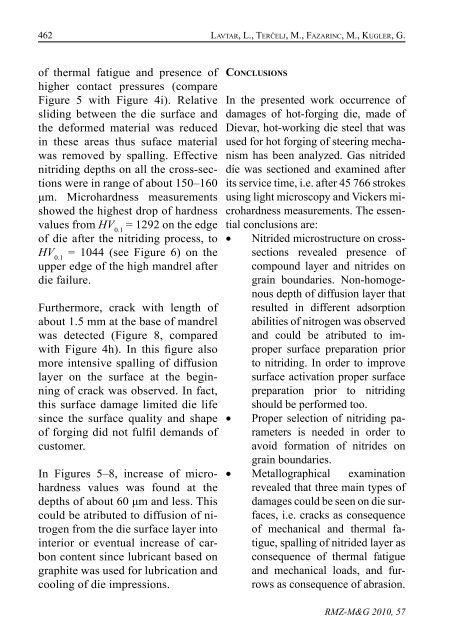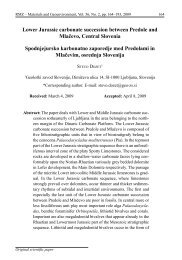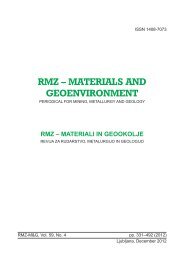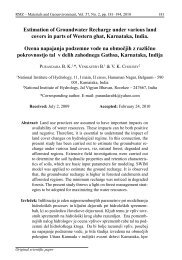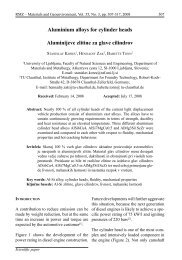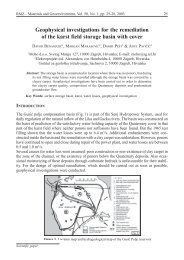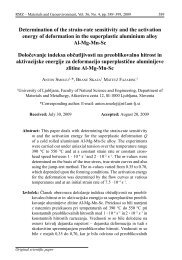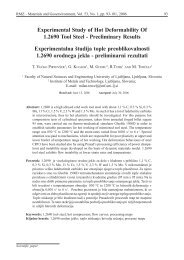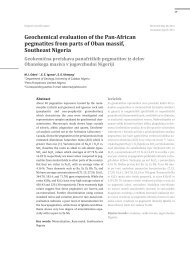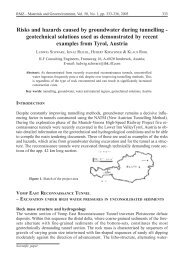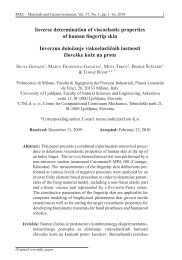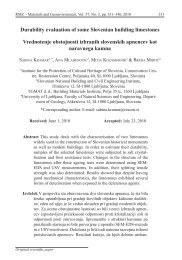Main damages on upper die in industrial hot forging Glavne ... - RMZ
Main damages on upper die in industrial hot forging Glavne ... - RMZ
Main damages on upper die in industrial hot forging Glavne ... - RMZ
Create successful ePaper yourself
Turn your PDF publications into a flip-book with our unique Google optimized e-Paper software.
462 Lavtar, L., Terčelj, M., Fazar<strong>in</strong>c, M., Kugler, G.of thermal fatigue and presence ofhigher c<strong>on</strong>tact pressures (compareFigure 5 with Figure 4i). Relativeslid<strong>in</strong>g between the <strong>die</strong> surface andthe deformed material was reduced<strong>in</strong> these areas thus suface materialwas removed by spall<strong>in</strong>g. Effectivenitrid<strong>in</strong>g depths <strong>on</strong> all the cross-secti<strong>on</strong>swere <strong>in</strong> range of about 150–160μm. Microhardness measurementsshowed the highest drop of hardnessvalues from HV 0.1= 1292 <strong>on</strong> the edgeof <strong>die</strong> after the nitrid<strong>in</strong>g process, toHV 0.1= 1044 (see Figure 6) <strong>on</strong> the<strong>upper</strong> edge of the high mandrel after<strong>die</strong> failure.Furthermore, crack with length ofabout 1.5 mm at the base of mandrelwas detected (Figure 8, comparedwith Figure 4h). In this figure alsomore <strong>in</strong>tensive spall<strong>in</strong>g of diffusi<strong>on</strong>layer <strong>on</strong> the surface at the beg<strong>in</strong>n<strong>in</strong>gof crack was observed. In fact,this surface damage limited <strong>die</strong> lifes<strong>in</strong>ce the surface quality and shapeof forg<strong>in</strong>g did not fulfil demands ofcustomer.In Figures 5–8, <strong>in</strong>crease of microhardnessvalues was found at thedepths of about 60 μm and less. Thiscould be atributed to diffusi<strong>on</strong> of nitrogenfrom the <strong>die</strong> surface layer <strong>in</strong>to<strong>in</strong>terior or eventual <strong>in</strong>crease of carb<strong>on</strong>c<strong>on</strong>tent s<strong>in</strong>ce lubricant based <strong>on</strong>graphite was used for lubricati<strong>on</strong> andcool<strong>in</strong>g of <strong>die</strong> impressi<strong>on</strong>s.C<strong>on</strong>clusi<strong>on</strong>sIn the presented work occurrence of<str<strong>on</strong>g>damages</str<strong>on</strong>g> of <strong>hot</strong>-forg<strong>in</strong>g <strong>die</strong>, made ofDievar, <strong>hot</strong>-work<strong>in</strong>g <strong>die</strong> steel that wasused for <strong>hot</strong> forg<strong>in</strong>g of steer<strong>in</strong>g mechanismhas been analyzed. Gas nitrided<strong>die</strong> was secti<strong>on</strong>ed and exam<strong>in</strong>ed afterits service time, i.e. after 45 766 strokesus<strong>in</strong>g light microscopy and Vickers microhardnessmeasurements. The essentialc<strong>on</strong>clusi<strong>on</strong>s are:• Nitrided microstructure <strong>on</strong> crosssecti<strong>on</strong>srevealed presence ofcompound layer and nitrides <strong>on</strong>gra<strong>in</strong> boundaries. N<strong>on</strong>-homogenousdepth of diffusi<strong>on</strong> layer thatresulted <strong>in</strong> different adsorpti<strong>on</strong>abilities of nitrogen was observedand could be atributed to impropersurface preparati<strong>on</strong> priorto nitrid<strong>in</strong>g. In order to improvesurface activati<strong>on</strong> proper surfacepreparati<strong>on</strong> prior to nitrid<strong>in</strong>gshould be performed too.• Proper selecti<strong>on</strong> of nitrid<strong>in</strong>g parametersis needed <strong>in</strong> order toavoid formati<strong>on</strong> of nitrides <strong>on</strong>gra<strong>in</strong> boundaries.• Metallographical exam<strong>in</strong>ati<strong>on</strong>revealed that three ma<strong>in</strong> types of<str<strong>on</strong>g>damages</str<strong>on</strong>g> could be seen <strong>on</strong> <strong>die</strong> surfaces,i.e. cracks as c<strong>on</strong>sequenceof mechanical and thermal fatigue,spall<strong>in</strong>g of nitrided layer asc<strong>on</strong>sequence of thermal fatigueand mechanical loads, and furrowsas c<strong>on</strong>sequence of abrasi<strong>on</strong>.<strong>RMZ</strong>-M&G 2010, 57


